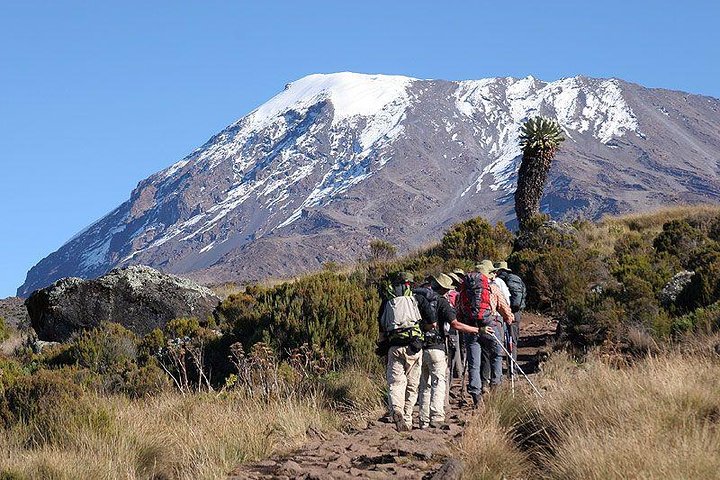Tips for Hiking Mount Kilimanjaro
What You Need To Know Before Climbing Mount Kilimanjaro?
Mount Kilimanjaro National Park, located in northeastern Tanzania, is a UNESCO World Heritage Site and home to Africa’s tallest peak, Mount Kilimanjaro. Covering an area of approximately 1,668 square kilometers (641 square miles), the park encompasses a diverse range of ecosystems and offers visitors the opportunity to embark on the adventure of a lifetime. Here’s an original overview of this iconic park:
Mount Kilimanjaro stands as a majestic sentinel, its snow-capped peak piercing the African skies. The mountain, a dormant stratovolcano, comprises three main volcanic cones: Kibo, Mawenzi, and Shira. At 5,895 meters (19,341 feet) above sea level, Uhuru Peak, located on Kibo, is the highest point on the continent.
The park’s terrain is a testament to the power of nature, featuring lush montane forests, expansive moorlands, rugged alpine deserts, and pristine glaciers. Each ecosystem harbors its own unique biodiversity, adapted to the varying altitudes and climatic conditions.
Lower slopes are cloaked in verdant montane forests, where ancient trees tower overhead and a symphony of birdcalls fills the air. Here, elusive creatures like the colobus monkey and blue monkey find sanctuary amidst the dense foliage. As altitude increases, the landscape transforms into heath and moorland, characterized by giant lobelias and other hardy plants resilient to the harsh conditions.

Ascending further, the vegetation thins, giving way to an otherworldly alpine desert where the air is thin and the ground barren. Yet, even in these seemingly inhospitable environments, life persists. Endemic plant species, like the resilient Kilimanjaro cabbage, cling to rocky outcrops, defying the odds. While the mountain’s higher reaches may appear desolate, they are not devoid of life. Though sightings of large mammals are rare due to the altitude, keen-eyed adventurers may spot the diminutive Kilimanjaro tree hyrax or glimpse the silhouette of a lammergeier soaring overhead.
For many, the allure of Mount Kilimanjaro lies in the challenge of summiting its lofty peak. Several routes, each with its own characteristics and scenic vistas, wind their way to Uhuru Peak. The Marangu Route, with its comfortable hut accommodations, is favored by those seeking a less rugged experience, while the Machame and Lemosho Routes offer stunning panoramas and a more immersive wilderness experience.
Conservation efforts within Mount Kilimanjaro National Park aim to safeguard its fragile ecosystems and mitigate the impacts of climate change on the mountain’s glaciers and vegetation. Sustainable tourism practices, including waste management initiatives and responsible climbing guidelines, are integral to preserving the park’s natural integrity for future generations. Mount Kilimanjaro National Park is more than a geographical landmark; it’s a symbol of human resilience and the indomitable spirit of adventure. As visitors tread its trails and ascend its slopes, they embark on a journey of self-discovery, forging memories that will endure long after they’ve descended from the Roof of Africa.
10 Best Tips for Hiking Mount Kilimanjaro
Choose the Right Route: Kilimanjaro has several routes (Marangu, Machame, Lemosho, Rongai, Shira, and Umbwe), each with different difficulty levels, scenic views, and success rates. Research and select the one that best matches your fitness level and preferences.
Acclimatize Properly: Altitude sickness is a significant concern. Opt for longer routes to increase your chances of acclimatizing and reaching the summit successfully.
Train in Advance: Physical preparation is crucial. Engage in regular aerobic exercise, strength training, and hiking to build stamina and endurance.
Pack the Essentials: Carry high-quality gear, including thermal clothing, a sturdy backpack, a reliable sleeping bag, and essential medications. Layering is key to managing varying temperatures.
Stay Hydrated: Drink plenty of water to combat dehydration and help your body adjust to the altitude.
Pace Yourself: “Pole pole” (slowly, slowly) is a common Swahili phrase on the mountain. Walking slowly helps your body adjust to the altitude and conserves energy.
Hire Experienced Guides: Choose a reputable tour company with experienced guides who can provide support, advice, and safety measures.
Stay Positive and Motivated: Mental strength is as important as physical fitness. Keep a positive attitude and encourage fellow climbers.
Protect Against the Sun: Use sunscreen, wear a hat, and wear sunglasses to protect yourself from the strong sun at high altitudes.
Listen to Your Body: If you experience severe symptoms of altitude sickness, inform your guide and descend if necessary.
What To Pack For Climbing Mount Kilimanjaro (Packing/Gear List)
Appropriate Clothing: Pack light, moisture-wicking clothing suitable for both warm days and cooler nights. Layering is key to adapting to temperature changes. Don’t forget to include waterproof clothing for unexpected showers.
Sturdy Footwear: Opt for well-fitted, broken-in hiking boots with ankle support to navigate uneven terrain comfortably. Quality socks to prevent blisters are also essential.
Sun Protection: Bring along sunscreen with high SPF, UV-protective sunglasses, and a wide-brimmed hat to shield yourself from the intense equatorial sun. Lipsalve with SPF is also recommended.
Medical Kit: Carry a basic medical kit containing essentials such as pain relievers, bandages, antiseptic wipes, and any personal medications. Consider including altitude sickness medication if ascending to higher elevations.
Hydration System: Stay hydrated by carrying a reusable water bottle or hydration bladder. Water purification tablets or a portable filter can be useful for refilling from natural water sources.
Backpack: Bring a comfortable day pack to carry essentials like water, snacks, camera gear, and extra clothing layers during excursions.
Flashlight or Headlamp: Essential for navigating trails and campsites after dark. Don’t forget to bring spare batteries or ensure it’s rechargeable.
Insect Repellent: Protect yourself from mosquitoes and other insects with a DEET-based or natural insect repellent. Consider packing mosquito nets or clothing treated with insect repellent for added protection.
Camera and Binoculars: Capture the stunning scenery and wildlife encounters with a quality camera and binoculars. Ensure you have sufficient memory cards, batteries, and lens cleaning supplies.
Travel Documents: Keep your passport, travel insurance details, permits, and any necessary vouchers in a waterproof pouch or organizer. It’s also wise to carry photocopies of important documents.